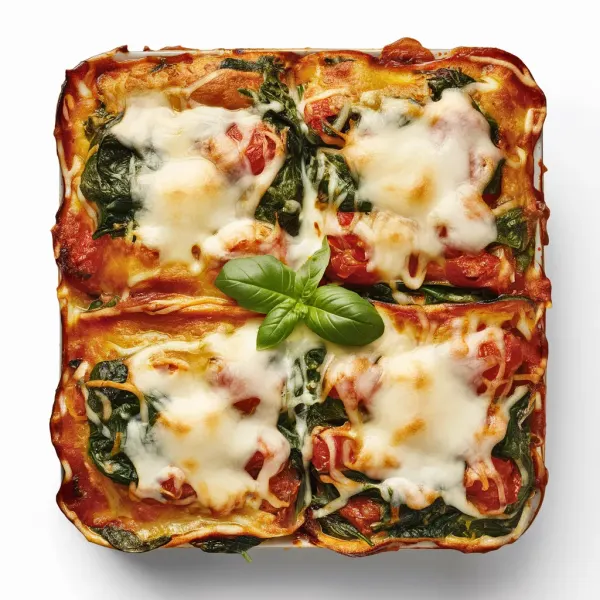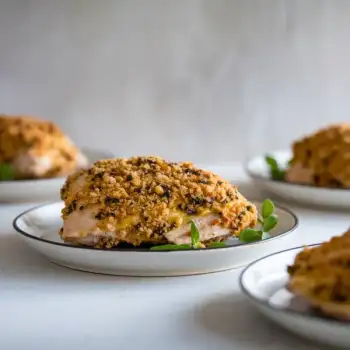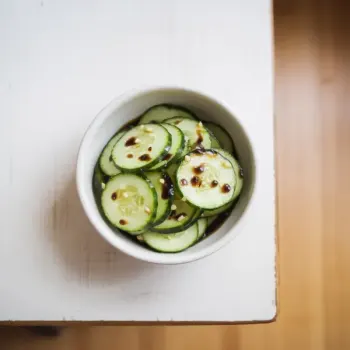
 100 minutes
100 minutesA delightful blend of hearty vegetables and rich, creamy flavors.


0 oz
Fresh Basil, chopped
cups
tablespoons
Garlic Clove, minced
each
teaspoons
teaspoons
cups
Parmesan Cheese, grated
cups
Garlic Clove, minced
each
teaspoons
teaspoons
teaspoons
Eggplant, peeled and cut into 1/2-inch pieces
0 lb
teaspoons
Zucchini, cut into 1/2-inch pieces
0 lb
Yellow Summer Squash, cut into 1/2-inch pieces
0 lb
tablespoons
Garlic Clove, minced
each
Fresh Thyme, minced
tablespoons
cups
Kalamata Olives, pitted and minced
cups
Whole-Milk Mozzarella Cheese, shredded
cups
No-boil Lasagna Noodles
0 oz
Fresh Basil, chopped
tablespoons
1. Preheat Oven
Preheat your oven to 375 degrees, ensuring the rack is in the middle position. This will provide even heat distribution for baking.
2. Prepare Tomato Sauce
To start with the tomato sauce, combine the crushed tomatoes, chopped basil, extra-virgin olive oil, minced garlic, kosher salt, and red pepper flakes in a bowl. Whisk these ingredients together until you have a uniformly combined mixture, which will ensure that the flavors meld together harmoniously.
3. Prepare Creamy Parmesan Sauce
Next, prepare the creamy Parmesan sauce. In another bowl, whisk together the whole-milk cottage cheese, heavy cream, grated Parmesan cheese, minced garlic, cornstarch, kosher salt, and pepper. Continue whisking until you achieve a smooth, homogeneous mixture. This will ensure a rich, creamy consistency for your lasagna.
4. Prepare Eggplant
For the vegetable filling, start by tossing the peeled and chopped eggplant with a teaspoon of salt in a large bowl. Spread the eggplant pieces on a plate lined with coffee filters and spray lightly with vegetable oil. Microwave the eggplant for about 10 minutes, tossing halfway through. This step is crucial as it helps to remove excess moisture from the eggplant, leaving it dry to the touch and slightly shriveled, which will prevent your lasagna from becoming watery.
5. Sauté Vegetables
While the eggplant is in the microwave, heat 5 tablespoons of olive oil in a skillet over medium heat. Add the zucchini, yellow squash, minced garlic, and fresh thyme, and sauté until the vegetables are tender. This combination of vegetables will add a delightful depth of flavor to your lasagna. Once tender, add the baby spinach and cook until wilted. Stir in the minced kalamata olives for an added burst of flavor.
6. Assemble Lasagna
Now, it's time to assemble the lasagna. In a baking dish, start with a layer of tomato sauce, followed by a layer of no-boil lasagna noodles. Spread a portion of the creamy Parmesan sauce over the noodles, then add a layer of the vegetable mixture, and sprinkle with shredded mozzarella cheese. Repeat these layers until all the ingredients are used, finishing with a layer of mozzarella on top.
7. Bake Lasagna
Cover the baking dish with aluminum foil and bake in the preheated oven for about 45-60 minutes, or until the lasagna is bubbling and the top is golden brown. Remove the foil during the last 10 minutes of baking to achieve a beautifully browned top.
8. Rest and Serve
Allow the lasagna to rest for about 10 minutes before serving. Just before serving, sprinkle with the remaining chopped fresh basil for a fresh finish. Enjoy your Rustic Garden Lasagna with Creamy Parmesan Sauce, a delightful blend of hearty vegetables and rich, creamy flavors.
Roasting your vegetables before layering them into the lasagna can concentrate and deepen their flavors, adding a layer of complexity that sautéing cannot match.
Opt for the freshest, in-season produce you can find. The flavor difference is significant, especially for a vegetable-centric dish like lasagna.
Grate your Parmesan cheese fresh and cook the sauce gently to avoid separation or graininess for the creamiest, smoothest result.
Start with a classic béchamel as a base, cooking the roux to a light golden color and whisking continuously while adding milk to prevent lumps.
Use high-quality or fresh pasta and cook it just to al dente since it will continue to cook in the oven, avoiding overcooked, mushy layers.




Comments (0)